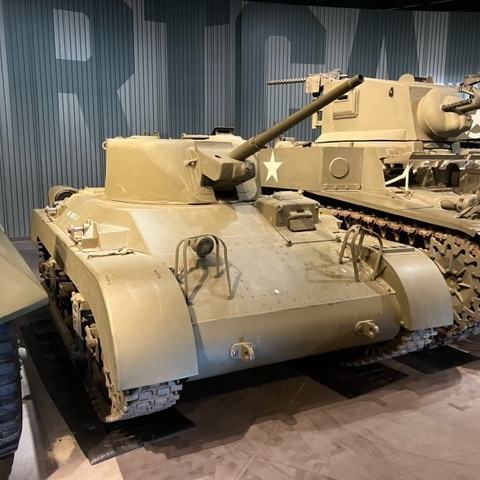
Published 2023-03-30

M22 Light Tank (Airborne) aka "Locust"
By Staff
M22 Light Tank (Airborne) aka "Locust" a New Addition to the Combat Vehicle Rotunda
Check out the M22 Light Tank (Airborne) aka "Locust" - one of the new additions that recently was installed in the Combat Vehicle Rotunda of our World War II gallery as part of our renovation and improvement of exhibits.
The M22 "Locust" tank, also known as the M22 Light Tank (Airborne), was a small but powerful tank used by the Allies during World War II. Developed by the American company Marmon-Herrington, the M22 was designed to be air-dropped into battle and support airborne operations. In this blog post, we'll take a closer look at the history, design, and legacy of this unique tank.

History:
The M22 was developed in response to a request from the British War Office for a light tank that could be transported by glider. At the time, the British were experimenting with airborne operations, including the famous Operation Market Garden, and needed a tank that could be delivered by air to support these missions. The Marmon-Herrington Company, which had experience designing armored vehicles, was awarded the contract to develop the new tank.
Design:
The M22 was a small tank, measuring just 12 feet 11 inches long and 7 feet 6 inches wide. It weighed only 10 tons and was powered by a 110-horsepower engine, giving it a top speed of 40 miles per hour. The tank had a range of 150 miles and could carry a crew of three: a commander, a gunner, and a driver.
One of the most distinctive features of the M22 was its ability to be air-dropped. The tank was designed to be carried by the C-54 aircraft, with the turret stowed inside the airplane and the hull suspended beneath. Although the tank could be reassembled in less than 10 minutes, the C-54 required a long runway that limited its usefulness. As a result, the M22 was primarily used in glider operations.
The M22 was armed with a 37-millimeter gun and a coaxial .30-caliber machine gun. Its armor thickness varied depending on the location on the tank, ranging from 4 to 25 millimeters. The frontal armor was around 12.5 millimeters thick, while the side and rear armor were thinner.

Legacy:
The M22 saw limited use during World War II, primarily in support of airborne operations in Normandy and the Rhineland. Although it was successful in these missions, the M22 was quickly phased out of service after the war. It was considered too small and lightly armored for modern warfare, and larger tanks with more firepower were developed to take its place.
Despite its short service life, the M22 left a lasting legacy in the history of armored warfare. Its small size and air-droppable design were groundbreaking at the time, and inspired the development of other light tanks and armored vehicles in the years that followed. The M22 also played an important role in the development of airborne operations, which would become a key tactic in modern warfare.
Today, the M22 is remembered as a unique and innovative tank that helped to shape the course of World War II and beyond. Several examples of the M22 can be found in museums and collections around the world, including the National Museum of Military Vehicles in the United States.
Conclusion:
The M22 "Locust" tank was a small but powerful tank that played an important role in the history of armored warfare. Developed in response to a request from the British War Office, the M22 was designed to be air-dropped into battle and support airborne operations. Although it saw limited use during World War II, the M22 left a lasting legacy in the development of light tanks and armored vehicles, and helped to shape the course of modern warfare. Today, the M22 remains an important part of the history of World War II and a fascinating example of military engineering and design.